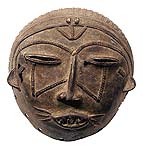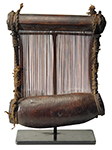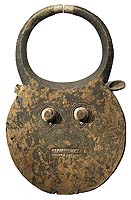Ram Masks Catalog |
Masks 3 Catalog |

Kplekple Goli Small Mask 35 |

Metal Masks |
Mask 4 |
BAULE FIGURES
Ram Masks Catalog |
Masks 3 Catalog |

Kplekple Goli Small Mask 35 |

Metal Masks |
Mask 4 |
BAULE FIGURES
Horseman 2 |
Female Figures |
Bo Usu Figures |
Figures |
Heddle Pulleys |
 BAULE Looms |
|
|
|
|
Doors Archives |
Harp 101 SOLD |
Pounders Archives |
 BAULE STYLE Kplekple Goli Masks Archives |
Goli glin Masks Archives |
Kplekple Goli Masks Archives |

Animal Masks Archives |
Couples Archives |
Maternity Figures Archives |
BAULE, SCULPTURE, Ivory Coast
The Baule are one of the Akan peoples. They moved west to the Ivory Coast more than 200 years ago and adopted sculptural and masking traditions from their neighbors, the Guro, Senufo and Yaure peoples.
Our winter exhibit, Baule Sculpture, from the Ivory Coast, presents the incongruity of incredibly beautiful and elegant work that was valued more for its spiritual presence than its workmanship and was usually kept secret and virtually unseen or viewed very rarely.
Baule masks range from the realistic and refined to the abstract and powerful. The best known are the quartet of masks worn during the Goli ritual of celebration and danced in sequence. Kplekple masks, representing junior males, are simple, flat, round and horned. Goli Glin masks, for senior males, are aggressively complex and very sculptural. Kpan pre masks, for junior females, are graceful and horned, Kpan masks, for senior females, represent idealized women of beauty and wisdom. All were danced by men.
Bo nun amuin, the sacred and fearsome bushcow/antelope men's masks, kept in the bush and hidden from women and children, show the serious and powerful potential of Baule spirits. Mblo secular masks, portraits of particular individuals, were danced in a more public performance. We have double (twin) masks, realistic ram masks and small metal masks that complement the more well known types.
Although Baule figures had a wide range of use, the actual function of the figures is not easy for outsiders to determine. All were thought to be inhabited by spirits and did not represent ancestors. Small figures include the roughly carved bo usu that helped with hunting and the more refined blolo bla (spirit wife) and blolo bian (spirit husband) that, if well taken care of, helped their human partners in all areas of life. Asye usu figures were the abode of spirits associated with diviners. In ritual performances the spirit would come out to possess the diviner, causing a trance. The display of the figures would enhance and support the ensuing dance. Figures carved by the Attie (southern neighbors of the Baule and like them, members of the Akan people) share the careful detailing and virtuosity typical of Baule carving but have more muscular limbs and small pegs imitating scarification patterns.
Unlike most of the masks and figures, Baule doors were intended to be seen. The elegant low reliefs depict figures, heads, crocodiles, birds, objects and abstract patterns with precision and balanced asymmetry, permanent displays of Baule artistic skill. Mbra monkey figures, gbekle mouse oracles, prestige spoons, staffs and other artifacts complete the exhibition.
We recommend Baule: African Art Western Eyes by Susan M. Vogel (Yale).
TRIBE |
OBJECT |